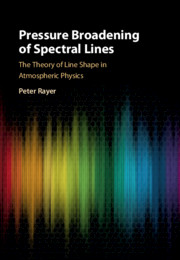Book contents
- Frontmatter
- Dedication
- Contents
- Preface
- Part One Preparing the Way
- 1 Introduction
- 2 Fundamental Ideas
- 3 Molecules at Work
- Part Two Broadening Theory
- Part Three Atmospheric Spectra
- Part Four The Background
- Appendix 1 State Space
- Appendix 2 Product Space
- Appendix 3 Projectors
- Appendix 4 Vector Operators
- Appendix 5 Quantum Dynamics
- Appendix 6 Scattering Theory
- Appendix 7 Resolvent Methods
- Appendix 8 Linear Response
- Appendix 9 Correlation Function
- Appendix 10 Complex Time
- Appendix 11 Absorption
- Appendix 12 Multipole Moments
- Appendix 13 Angular Momentum
- Appendix 14 The Wigner–Eckart Theorem
- Appendix 15 Reduced Amplitudes
- Appendix 16 Units and Other Matters
- Appendix 17 Plasma Spectra: Pointers
- Notes
- References
- Index
2 - Fundamental Ideas
from Part One - Preparing the Way
Published online by Cambridge University Press: 26 June 2020
- Frontmatter
- Dedication
- Contents
- Preface
- Part One Preparing the Way
- 1 Introduction
- 2 Fundamental Ideas
- 3 Molecules at Work
- Part Two Broadening Theory
- Part Three Atmospheric Spectra
- Part Four The Background
- Appendix 1 State Space
- Appendix 2 Product Space
- Appendix 3 Projectors
- Appendix 4 Vector Operators
- Appendix 5 Quantum Dynamics
- Appendix 6 Scattering Theory
- Appendix 7 Resolvent Methods
- Appendix 8 Linear Response
- Appendix 9 Correlation Function
- Appendix 10 Complex Time
- Appendix 11 Absorption
- Appendix 12 Multipole Moments
- Appendix 13 Angular Momentum
- Appendix 14 The Wigner–Eckart Theorem
- Appendix 15 Reduced Amplitudes
- Appendix 16 Units and Other Matters
- Appendix 17 Plasma Spectra: Pointers
- Notes
- References
- Index
Summary
The fundamentals are introduced, starting with the interaction of one system with another at the quantum level, and introducing the perturbation series. In the case of a gas interacting with a weak electromagnetic field, the series may be truncated at the linear term and used to provide the rate at which radiatively induced dipole transitions will occur between any two spectral states of the gas. Under equilibrium conditions this rate will exhibit a balance between the induced emission and pure absorption that is characterized by the important fluctuation–dissipation theorem, and leads, when translated into a power loss in the field, to an expression for the net absorption coefficient. Within this, there resides a spectral density function, essentially the line shape, which is shown to be the Fourier transform of the autocorrelation function for the active dipole moment, a statistical measure for the fluctuations in the dipole due to molecular collisions within the gas. The spectral density may then be identified, through the Wiener–Khinchin theorem, with the power spectrum of the dipole fluctuations, and stands ready for a reduction to the molecular level.
Keywords
- Type
- Chapter
- Information
- Pressure Broadening of Spectral LinesThe Theory of Line Shape in Atmospheric Physics, pp. 19 - 48Publisher: Cambridge University PressPrint publication year: 2020



